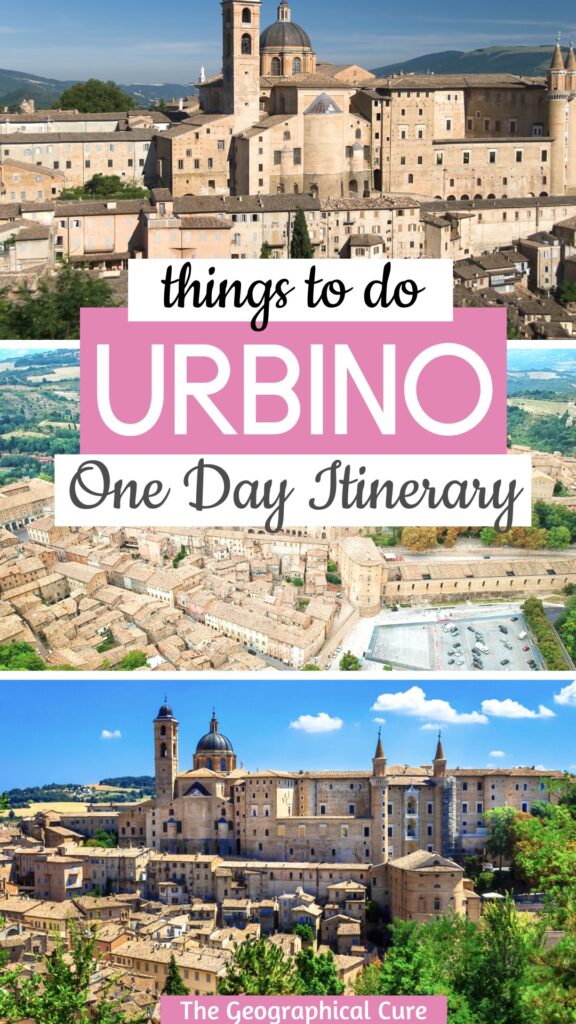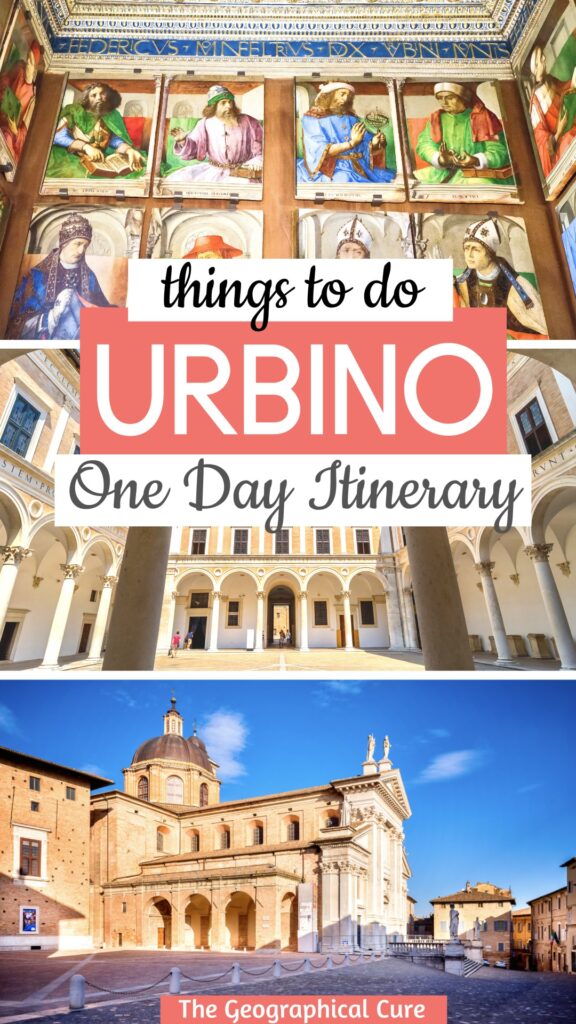UNESCO-listed Urbino is one of the prettiest and steepest hill towns in Italy. It’s a veritable Renaissance time capsule, famous as the hometown of artist Raphael and architect Donato Bramante.
Urbino was a court city. Its Renaissance fame is thanks in large part to one person, the Duke of Montefeltro.
If you’d like to visit, this is the ultimate one day in Urbino itinerary. It covers all the best things to do in this beautiful and underrated city.
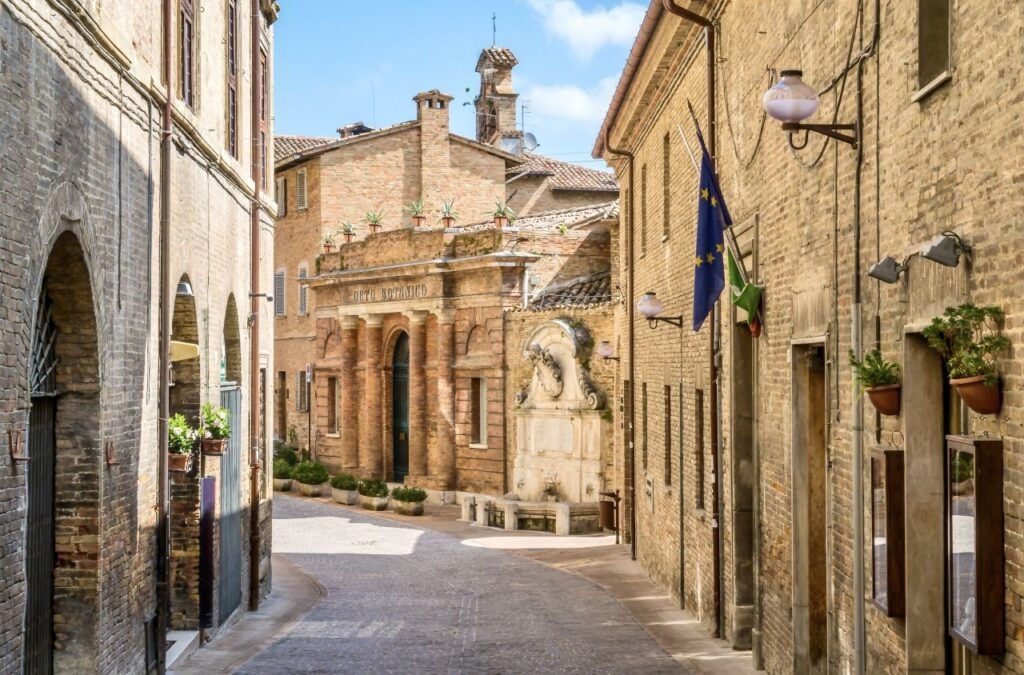
Snapshot Of One Day In Urbino
Here’s a quick glance of what you can see with this itinerary:
- Piazza della Repubblica
- Urbino Cathedral
- Ducal Palace
- Church of San Bernardino
- Oratory of St. John
- Raphael’s Birthplace
- Albornoz Fortress
>>> Click here to book a walking tour with a Ducal Palace ticket
A Short History of Montefeltro & Urbino
Federico is the singular man in Urbino’s history. He began life as the bastard son of a small town nobleman.
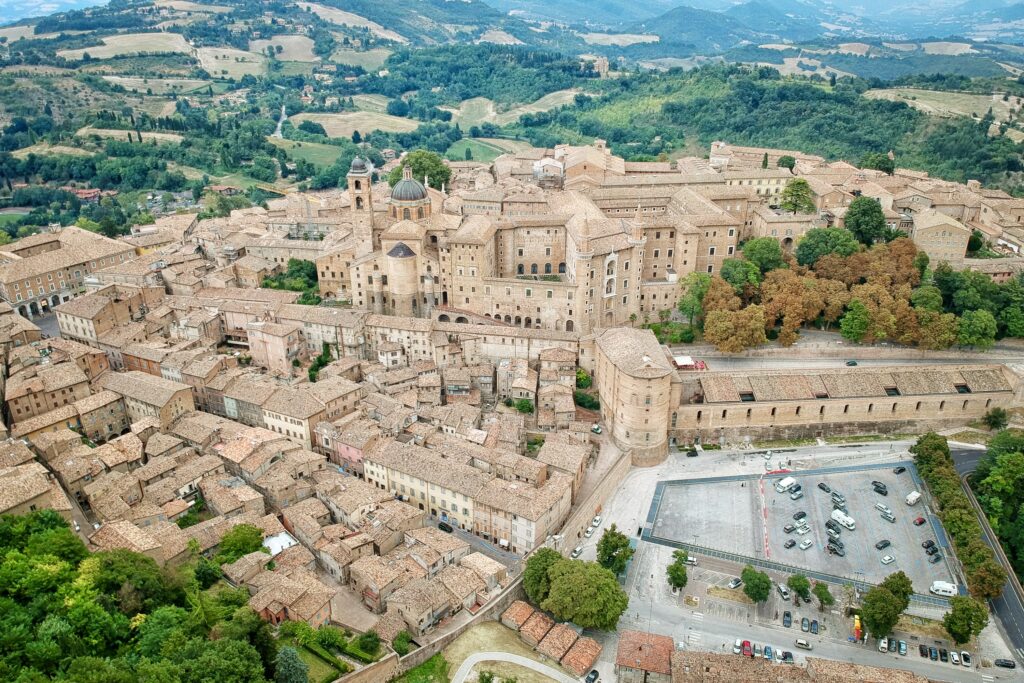
Legend holds that he seized power by killing his half brother, the rightful heir. Though there is no solid evidence to back up this salacious claim.
Federico became a famous mercenary general. He made money by selling his private armies to the highest bidder.
After amassing a fortune, the duke transformed Urbino into a cultural center rivaling Florence, attracting artists like Piero della Francesca, Paolo Uccello, and Raphael’s father, Giovanni Santi.
He settled down to life as a scholar, intellectual, and Renaissance gentleman.
During a joust, the duke lost his his right eye and a chunk of his hawk-shaped nose. Thus, in portraits of him, he’s always portrayed in profile, like the famous double portrait in the Uffizi Gallery.
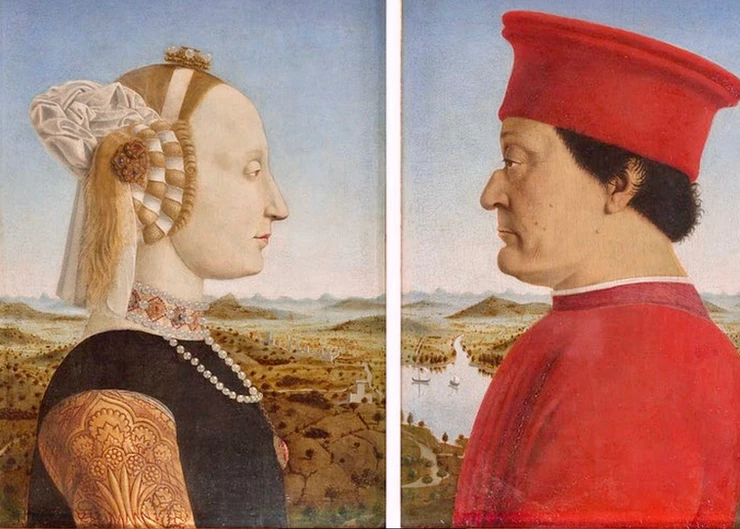
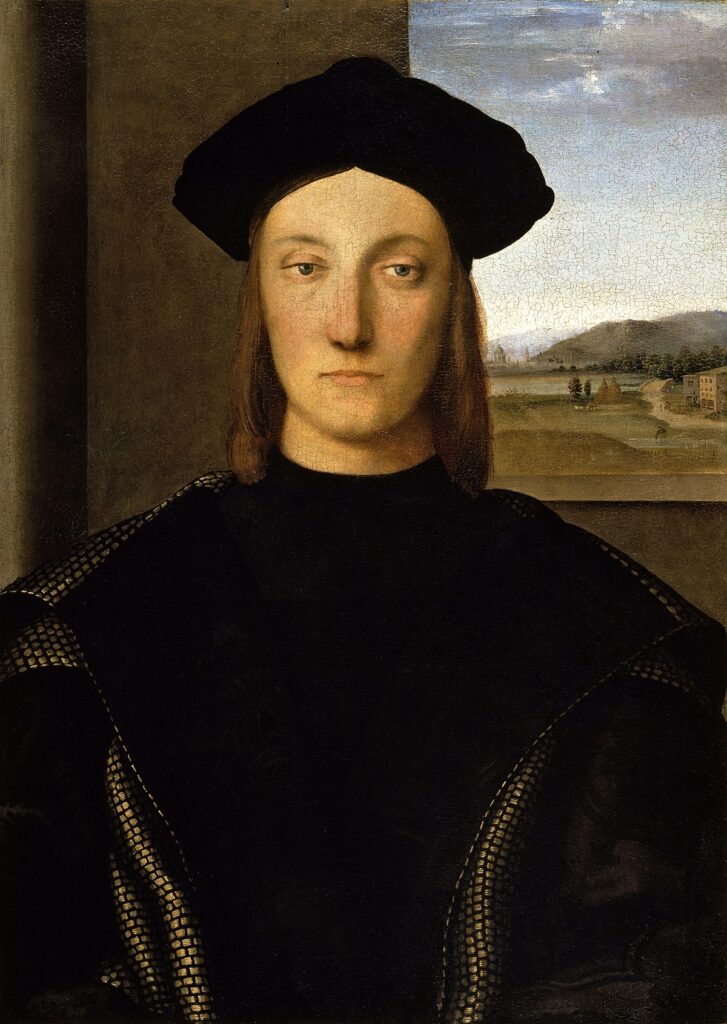
The duke married twice and was widowed twice. He had six daughters and a son, Guidobaldo.
Urbino’s court was so famous that, even after the duke’s death, people continued to flock to the city. Among those was Baldassare Castiglione, a member of Guidobaldo’s entourage.
Castiglione authored the Renaissance classic The Book of the Courtier. It’s a fascinating book on court life, akin to Machiavelli’s The Prince.
But Guidobaldo wasn’t his father. He was in poor health and died young, at age 36, without heirs. The Montefeltro fortune passed to the della Rovere family in Rome.
Today, Urbino is a small town with around 24,000 residents, mostly students from the local university.
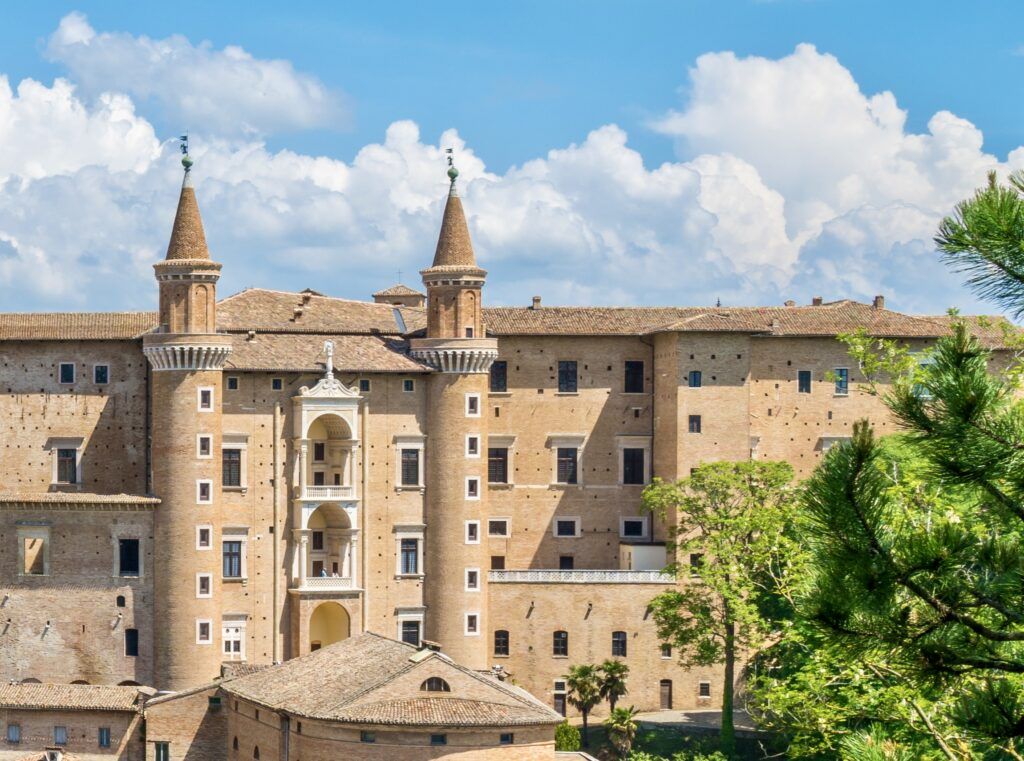
It thrives by catering to students rather than tourists, offering a unique and less touristy experience. While historically and artistically important, Urbino feels off the beaten path.
Situated at 1,650 feet above sea level, Urbino is a classic hill town with a medieval wall featuring four gates. The town’s main square, Piazza della Repubblica, is the hub of cafes.
The city’s streets are steep and winding, with lanes turning into staircases. But the town is small, and the climbs are short.
The Ducal Palace is the top attraction. There, you can admire paintings by the likes of Raphael, Giovanni Santi, Titian, Paolo Uccello and Piero della Francesca, mostly commissioned by Federico.
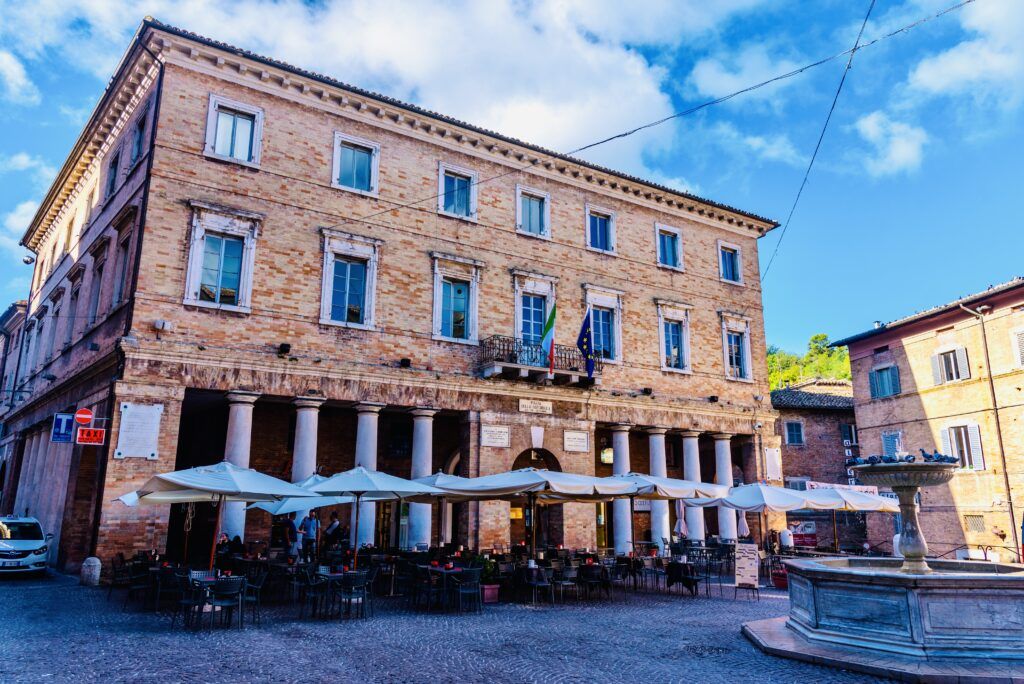
Things To Do With One Day In Urbino
Piazza della Repubblica
Begin your one day in Urbino at the main square, Piazza della Repubblica. It’s the city’s main square, located at the crossing of five streets.
The square is surrounded by a stunning ensemble of Renaissance buildings, showcasing the architectural elegance and grandeur of the period.
Grab a coffee or a pastry at one of the cafes to fuel up for the day ahead.
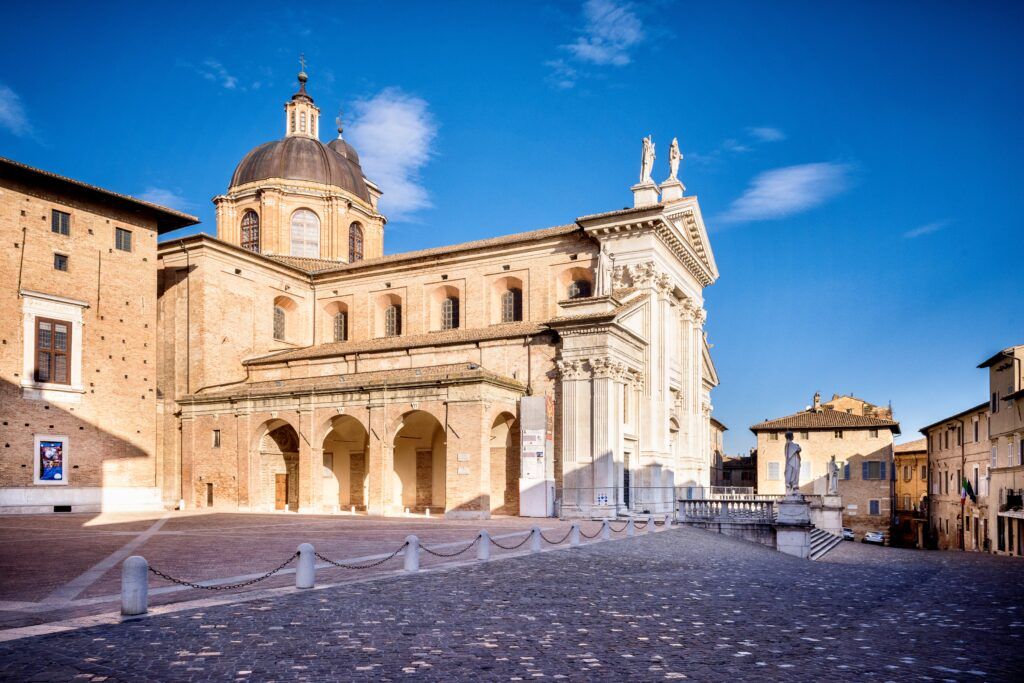
Urbino Cathedral
First, head to Urbino Cathedral, located on one side of the square. It’s a mammoth Neo-Classical church, a bit jarring next to the Renaissance architecture.
Like many churches in Italy, it’s dedicated to the Virgin Mary of the Assumption. The original church was designed by Francesco di Giorgio Martini in the 15th century. In the 18th century, however, it was rebuilt after an earthquake demolished its dome.
The stone-faced exterior looks like a Greek temple. Inside, it’s a true gem with a nave and two side aisles.
Explore its beautiful interior and admire the art and architecture. There are sculptures by Camillo Rusconi and paintings by a trio of Urbino artists.
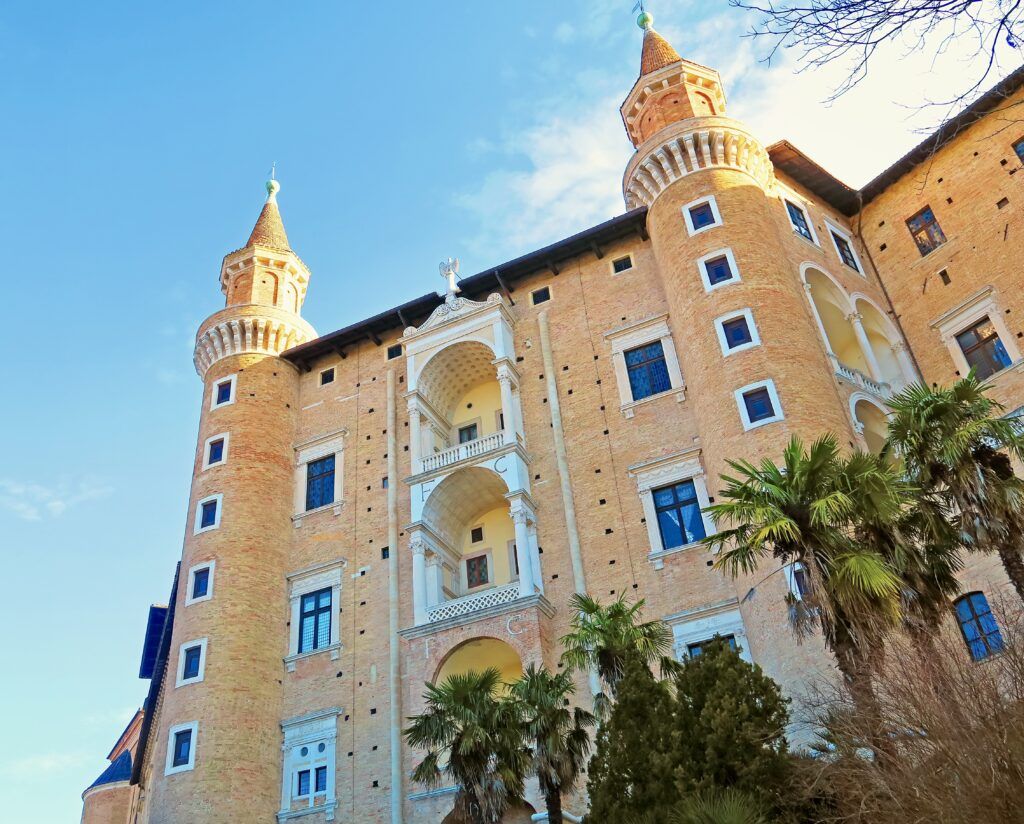
Palazzo Ducale | Ducal Palace
Next up, visit the impressive Ducal Palace, a UNESCO World Heritage Site.
It’s the #1 attraction and best thing to do in Urbino in one day. You can easily spend the rest of the morning here.
The architectural genius behind this masterpiece is Luciano Laurana, drawing inspiration from Florence’s Medici-Ricardi palace. His design blends beauty and fortification, and is marked by exquisite brickwork.
The western facade is the palace’s crowning jewel. A triumphal loggia is the center, framed by delicate twin towers. This loggia served as the platform from which the duke addressed his subjects.
The palace’s stonework is a testament to the meticulous craftsmanship of the master stone masons. It’s adorned with symbolic eagles, representing imperial power, as well as intricate floral and vegetable motifs.
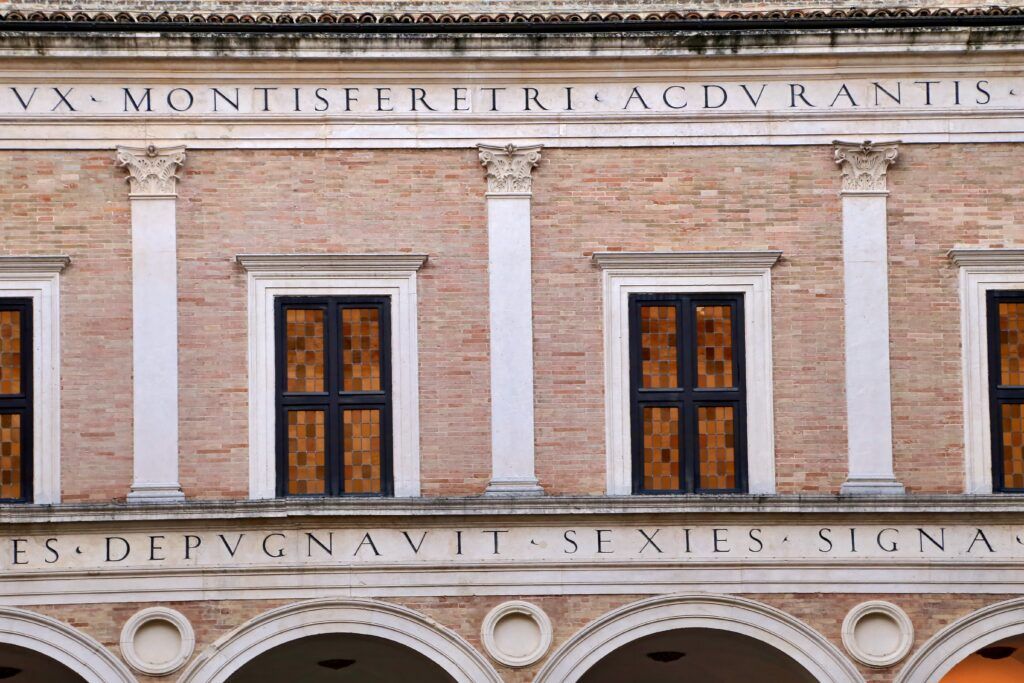
The palace, once home to around 200 individuals, was a proper royal residence. There are seven main apartments along with numerous smaller rooms for various purposes.
As you pass through the entrance and ticket desk, you’ll step into one of Italy’s most renowned Renaissance courtyards. It’s an architectural marvel of terraced elegance that almost takes on a metaphysical quality when bathed in sunlight.
Everywhere you look you see the inscriptions Federico’s Urbini Dux or FE DUX. There was no doubt who lived here!
On the first level, graceful semi-circular arches rest upon Corinthian columns. You can stroll beneath vaulted arcades articulated with elegant stone rosettes.
The upper level, added at a later date, seamlessly integrates with the architectural harmony below. It has a striking combination of white limestone and pink-toned brick.
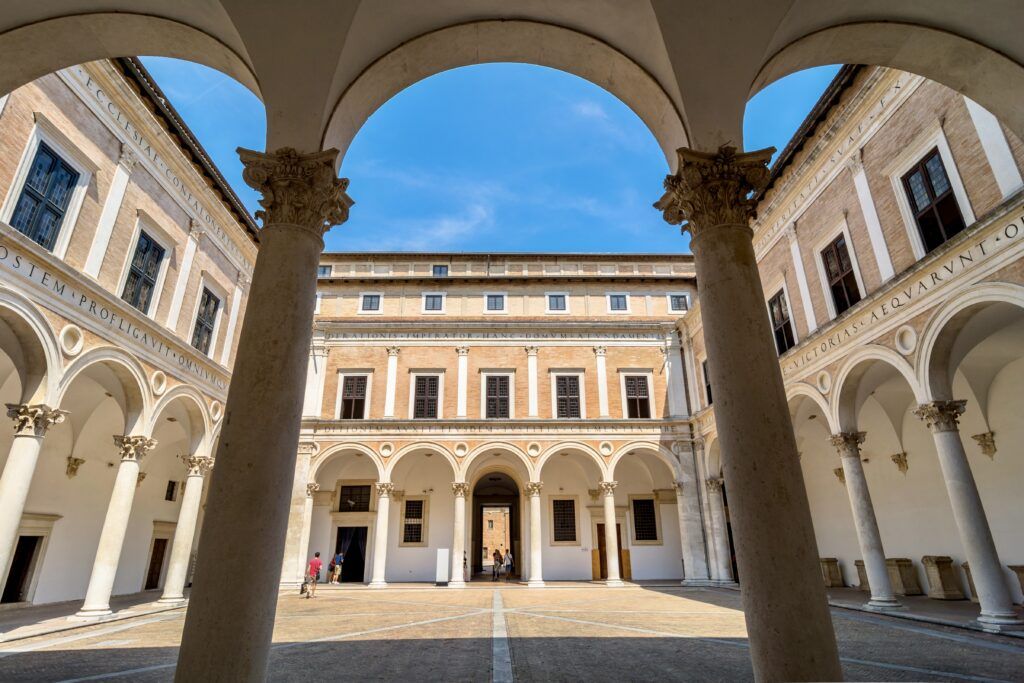
A Latin inscription runs along the entablature on both levels. It basically tells you that the duke was a rock star.
A little self aggrandizement is to be expected, after all. The duke had to promote the glory of his family and used the palace as propaganda.
Here are some of the palace highlights:
Audience Room
Upon entering, you’ll find yourself in the Audience Room, a spacious and somewhat austere chamber.
This area served as the waiting room for visitors seeking an audience with the duke. Its expansive size was intentional, meant to intimate the duke’s visitors.
As you approach the doors, look at the intricate lintels framing them. One of these doors features exquisite inlaid woodwork crafted by a young Botticelli.
The room’s fireplace has a Greek-style decoration. An eagle is positioned prominently above it. The choice of non-Christian, secular decoration in this space underscores its domestic purpose.
National Museum
The next set of rooms house the National Museum of the Marche, which has some significant artworks.
The prize masterpiece of the collection is Raphael’s Portrait of a Gentlewoman, know as “La Muta.” It’s believed to have been painted between 1507 and 1510 during Raphael’s time in Urbino.
Another very famous painting is Piero della Francesco’s Flagellation of Christ. It’s a small painting, admired for its mathematical precision and accomplishments in perspective.
The Flagellation has baffled art historians in a big way for centuries. It’s a fresco painting depicting the biblical scene of the flagellation of Christ before the crucifixion.
But no one knows who the group of men are in the foreground, the iconography is ambiguous, and the two sections of the painting are incongruous.
The painting has a formal and conceptual complexity. It reflects Piero’s preoccupation with the Classical world, as evidenced by the architecture and golden statue.
The second Piero painting in the museum is Madonna and Child With Two Angels. Unmistakably Piero-esque characters, Mary holds an adult-looking baby Jesus. Against the cool gray wall, you can see Piero’s keenly observed treatment of light.
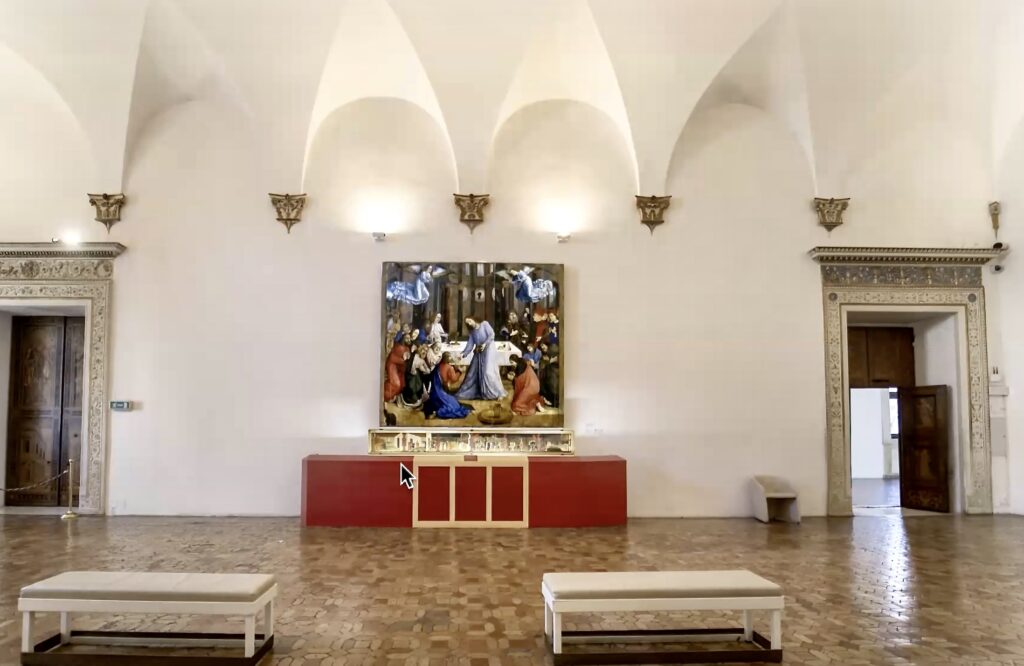
Angels’ Room
The next room is the Sala degli Angeli or “Angels’ Room.” It’s a white airy space that takes its name from the fun loving angels (with gold penises) decorating the fireplace mantle.
In this room, you can also see another famous painting, The Ideal City Panel, (possibly by Luciano Laurana). There are three of these panels in existence. The other two are in the Vatican and the Walters Museum in Baltimore.
It’s a visual architectural image devoid of any human presence. It’s like a window into another world one which was never realized.

The painting illustrates the architectural principles and theories of the 15th century — harmony, balance, and symmetry.
Nearby is another famous painting by Paolo Uccello, The Profanation of the Host. It’s a predella broken up into six scenes and shows the artist at the peak of his powers (with the exception of his famous battle scenes).
It’s a striking bit of 15th century anti-Semitic propaganda.
The images depicts a Jewish pawnbroker attempting to cook the sacred communion wafer to test the veracity of the theory of transubstantiation. When it bleeds, he’s executed at the stake.
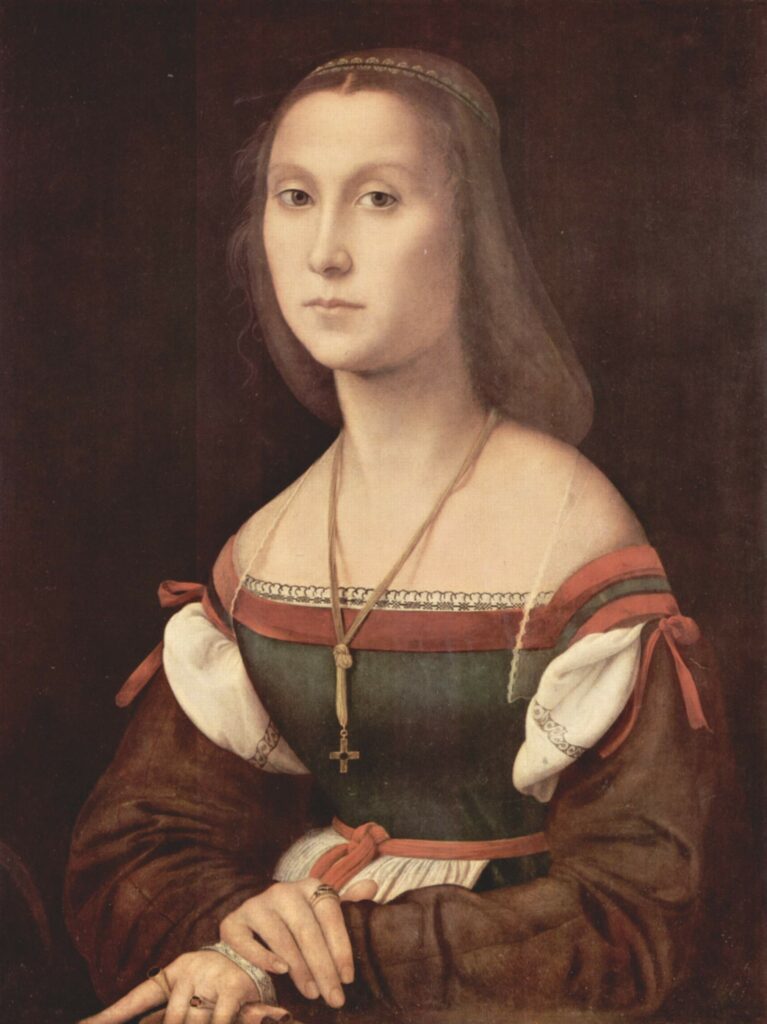
Duchess’ Bedroom
If that’s not enough art, you next walk into the Duchess’ Bedroom. There’s a large hanging tapestry.
The room is home to one of the Renaissance’s most celebrated paintings, La Muta (the silent one) by Raphael. It’s an early Raphael, but in his mature style.
La Muta is a remarkable portrait of an unidentified noblewoman. She is depicted with serene and graceful elegance. The woman’s gaze is enigmatic and her expression is rather melancholic.
For awhile, this painting was attributed to his teacher Perugino. Now, it’s universally attributed to Raphael. In true Raphael fashion, he catches all the psychological detail.
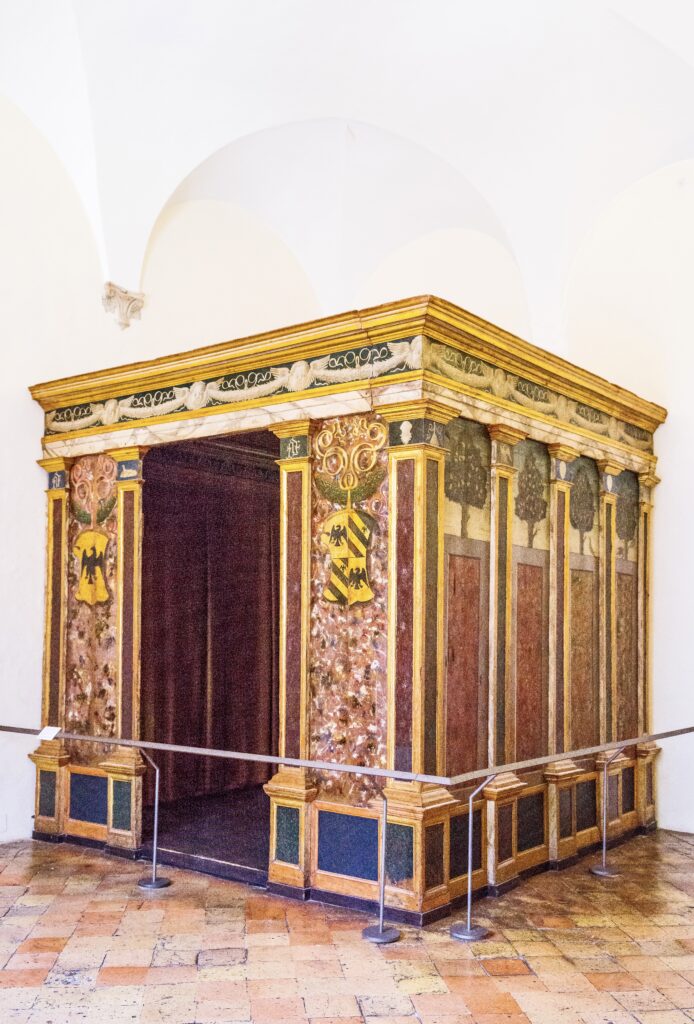
Duke’s Bedroom
Next, you’ll step into the Duke’s Bedroom. You’ll find a rare surviving piece of domestic furniture known as the “Alcove of the Duke,” crafted by Fra Giovanni in 1459.
This unique alcove served as a wooden enclosure for the duke’s bed. Its primary purpose was to create a dark atmosphere promoting a deep sleep. The alcove itself is adorned with opulent arboreal architectural details.
Inside the room, you’ll also come across a renowned painting from 1475 by Justus van Ghent. The double portrait features the duke and his son.
It offers the usual multifaceted portrayal of the duke. In it, he’s depicted both as a warrior and a man of intellect.
The duke is pictured reading the Urbino Bible, a significant illuminated manuscript, in his studiolo.
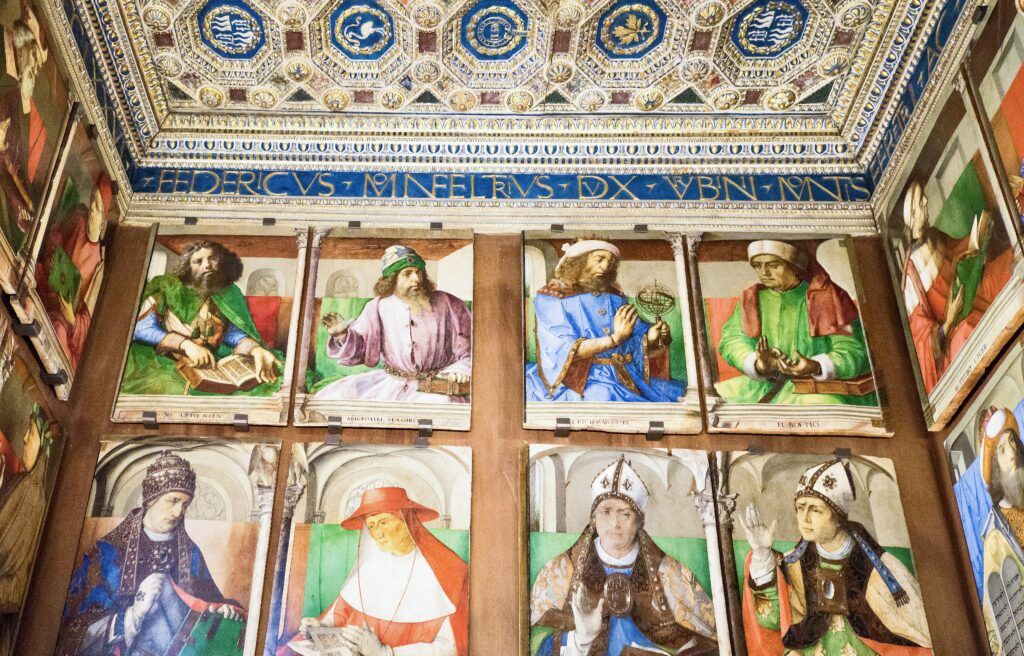
Duke’s Study
The study or studiolo is the real highlight of the palace. It’s a great wonder of 15th century Renaissance art.
This was a private space where the duke went to stimulate his intellect, meditate, and conduct private affairs.
It’s a small room inlaid with trompe l’oeil wooden panels showing the duke’s prowess in both war and culture. It’s the finest example of the Italian craft of wood inlay, called intarsia, in existence.
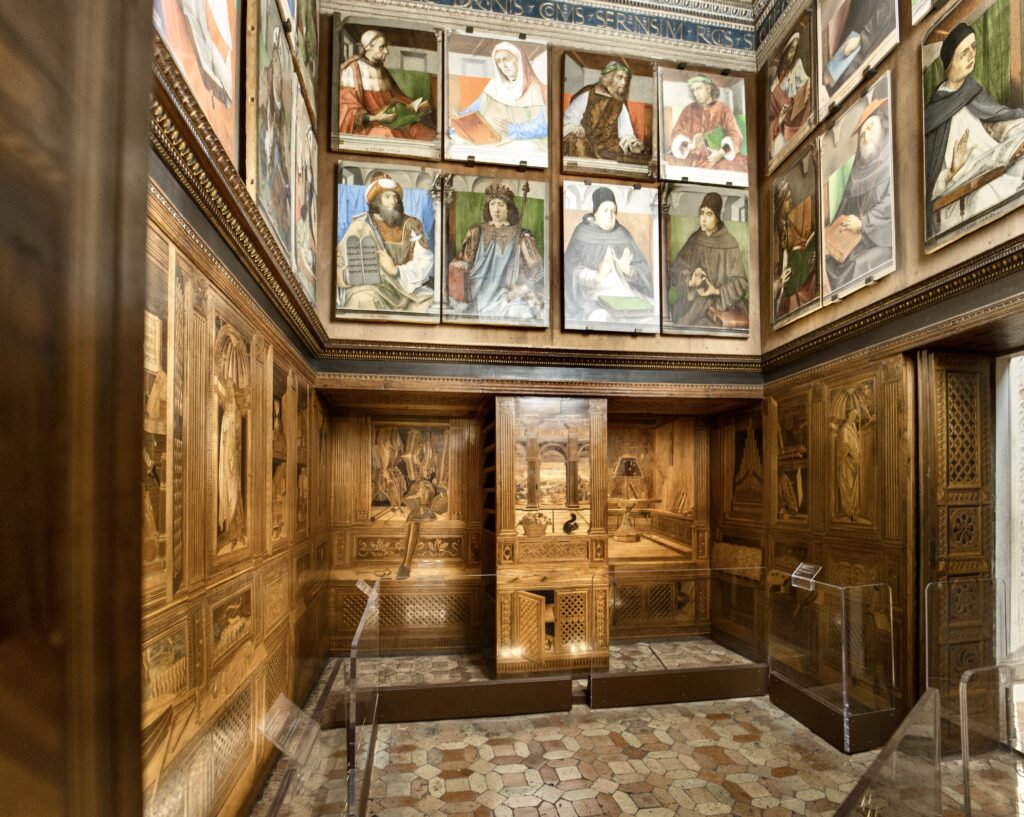
The room is made of 40 types of wood, including boxwood, beech, walnut, and ebony. The illusionism is simply extraordinary. The eye is tricked into seeing 3D cabinets and benches.
You can see objects belonging to the duke, including his armor and musical instruments. There are symbols everywhere. For example, an ermine signals purity, denying the claim that the duke killed his brother.
The walls are hung with portraits of “Illustrious Men,” Uomini Illustri. They are classical and humanistic writers and religious thinkers, who were basically the duke’s heroes and role models.
Only 14 of the original 28 portraits remain. The others are in the Louvre.
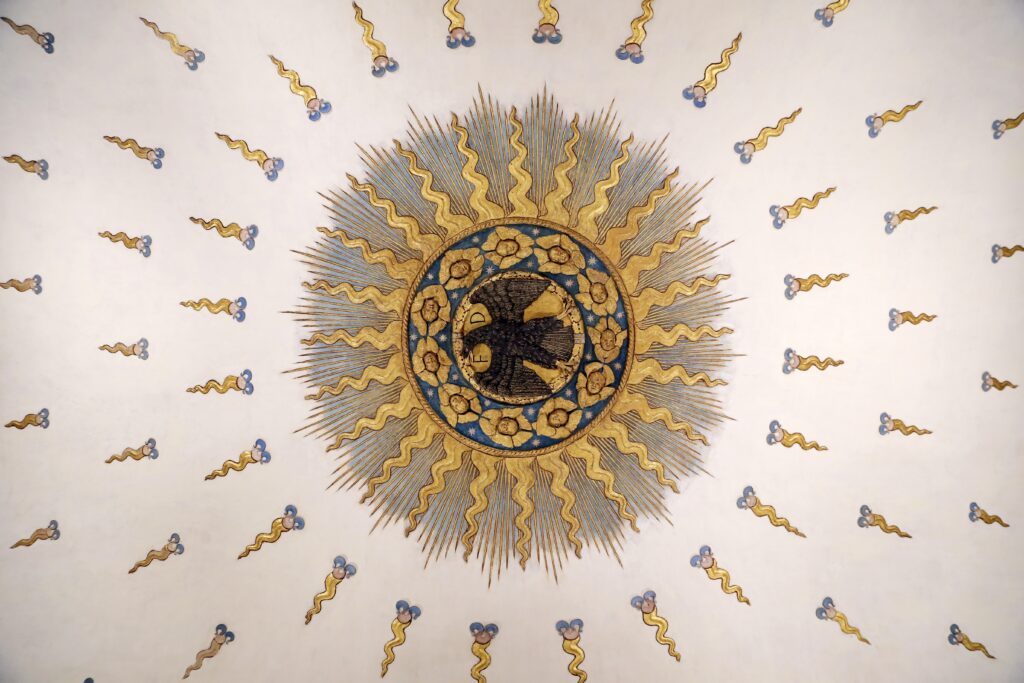
Library
Urbino was once home to one of Europe’s top classical libraries.
It was so important that, when the pope took over Urbino in 1657, he removed the duke’s collection of more than 2,000 manuscripts and carried them back to the Vatican.
Today, the library displays the travertine reliefs that used to decorate the palace exterior. The duke’s eagle-in-the-sun emblem on the ceiling symbolizes how he brought enlightenment to his realm.
Lunch
After your palace visit, take a break for lunch at a local trattoria or restaurant to savor some regional cuisine. There are also plenty of sandwich shops if you prefer that.
You can try Crescia, the local panino. It’s made with Montefeltro salami, Carpegna ham, Fossa pecorino cheese, and an ancient cheese called. Casciotta.
Church of San Bernardino
After lunch, head to the Church of San Bernardino. It’s a bit of a walk from the historic center. But it’s where the duke is buried and you can pay your respects.
The church was designed by the renowned Sienese architect Francesco di Giorgio Martini, who was active during the 15th century.
The church has been restored. Inside, you’ll find a copy of Piero della Francesca’s famous Montefeltro Altarpiece. The original is in the Brera Museum in Milan.
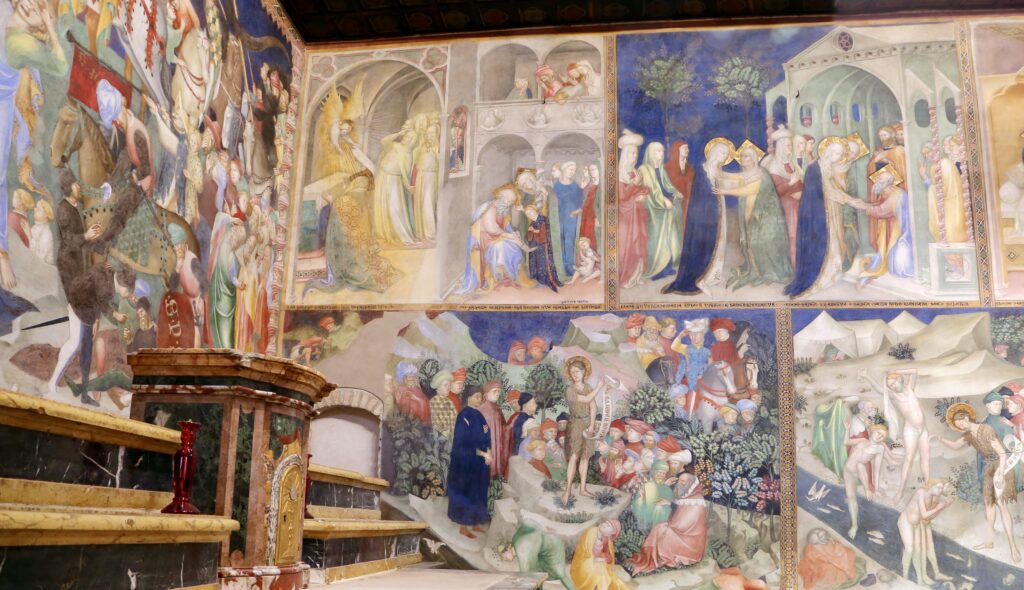
Oratory Of St. John
Then, visit the Oratorio di San Giovanni Battista, a small chapel known for its intricate frescoes. It’s the second best thing to do in Urbino, a beautiful interior space.
This religious sanctuary was constructed by a brotherhood dedicated to St. John the Baptist. The brotherhood practiced humble acts of Christian charity while wearing masks.
Inside, you’ll be immersed in the lively frescos narrating the life of St. John the Baptist, from his birth to his martyrdom. They were painted by Lorenzo and Giacomo Salimbeni in the early 15th century.
Be sure to focus on the thieves in the vivid crucifixion scene. An angel seizes the soul of one repentant thief, while the other falls into the clutches of a devil with mirror-like eyes.
Painted in 1400, prior to the advent of the Renaissance in Urbino, this artwork exemplifies the “International Gothic” style — a riot of color, intricate details, and decorative elements.
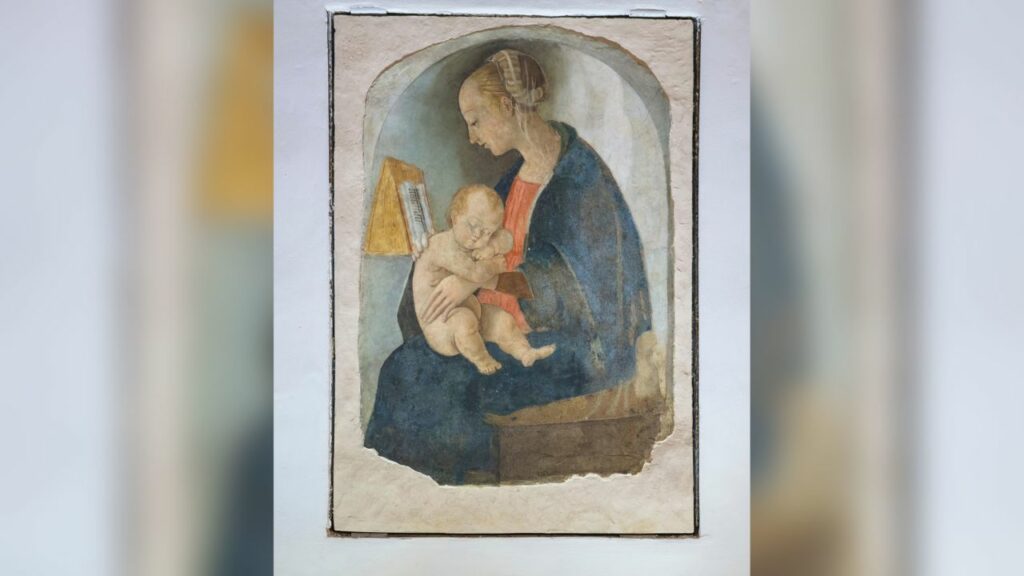
Raphael’s Birthplace
In the late afternoon, head to the Casa Natale di Raffaello, the birthplace of the famous artist Raphael. it’s open until 5:30 pm and costs € 3.50.
He was born there in 1483 and trained in his father’s workshop there. It’s just a 5 minute walk from the palace.
Explore the museum to learn more about his life and work. You can even seen where the artist ground his paints.
His earliest known painting, Madonna and Child, hangs on one wall. There’s also a painting by his lesser known father, who was a court painter for the duke.
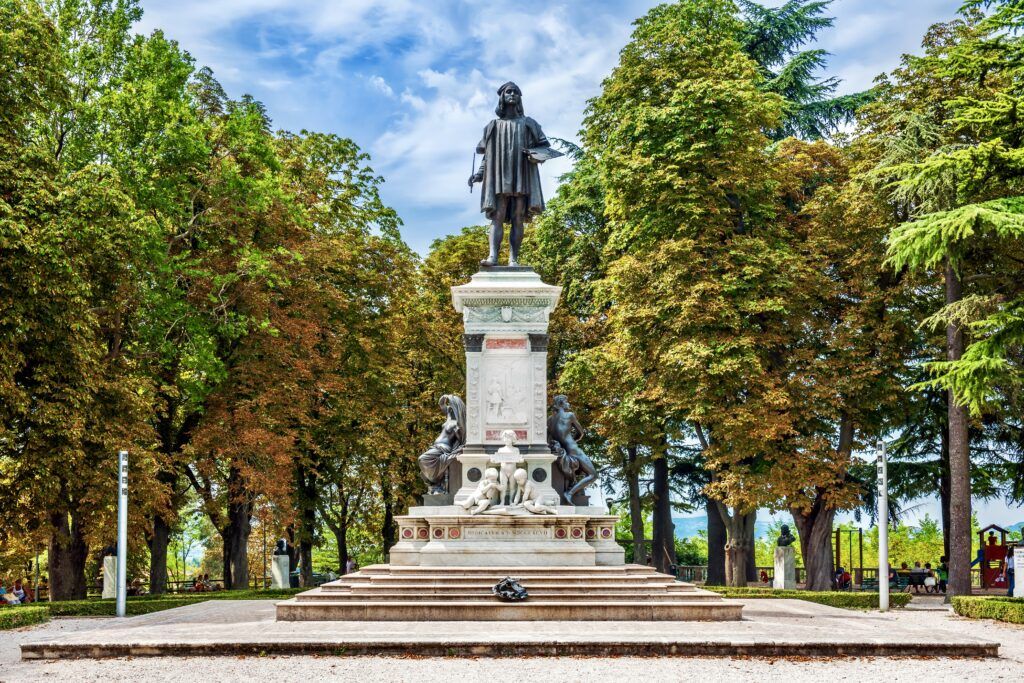
Raphael isn’t buried in Urbino. His remains are in the Pantheon in Rome. But Urbino has a replica of his tomb. It’s in the Church of San Francesco where the artist was baptized.
Fortress of Albornoz
Continue to the Fortress of Albornoz. Enroute, you’ll see a statue of Raphael in Piazza Roma.
There’s not much to see inside, but it offers classic panoramic views of Urbino and the surrounding landscape. It’s a great spot for photos.
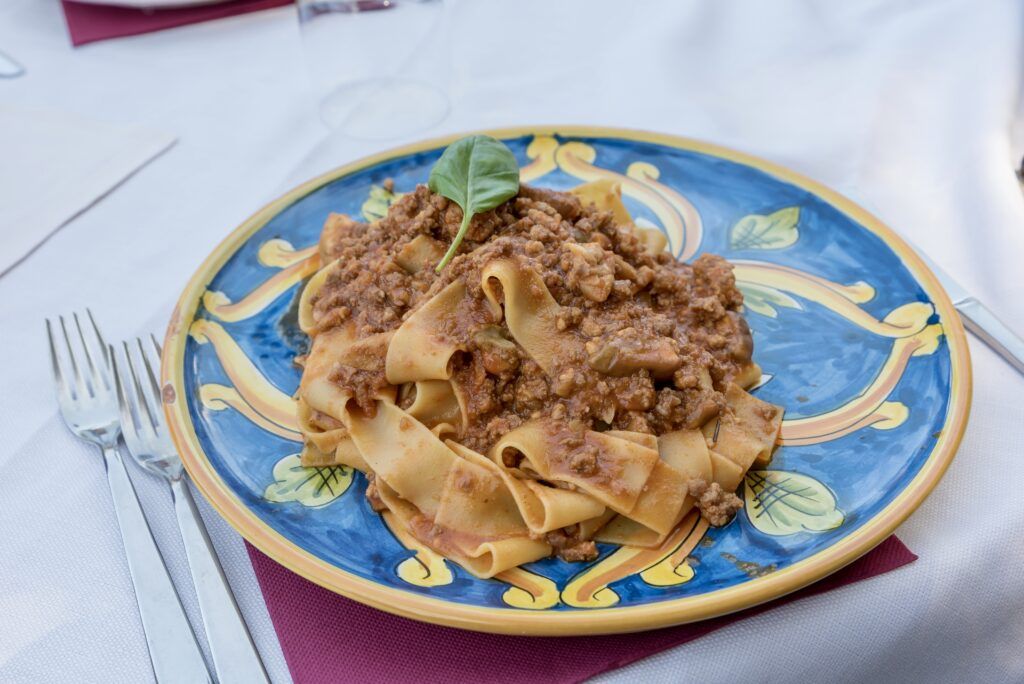
Dinner In Urbino
Walking in Urbino works up an appetitive. So, in the evening, enjoy a leisurely dinner at a local trattoria and savor the region’s delicious cuisine.
A good place to try is Taverna degli Artisti. It’s a restaurant with vaulted underground rooms and colorful frescos.
Not as atmospheric but with better food is Ristorante Antica Osteria Da La Stella. Another good spot is Osteria KM 0.
Some of the local specialties are cappelletti (small pasta dumplings in broth), tagliatelle alla Urbinate (pasta with meat sauce), truffles, and the “priest choker” (thick pasta with salmon, asparagus, and mushrooms).
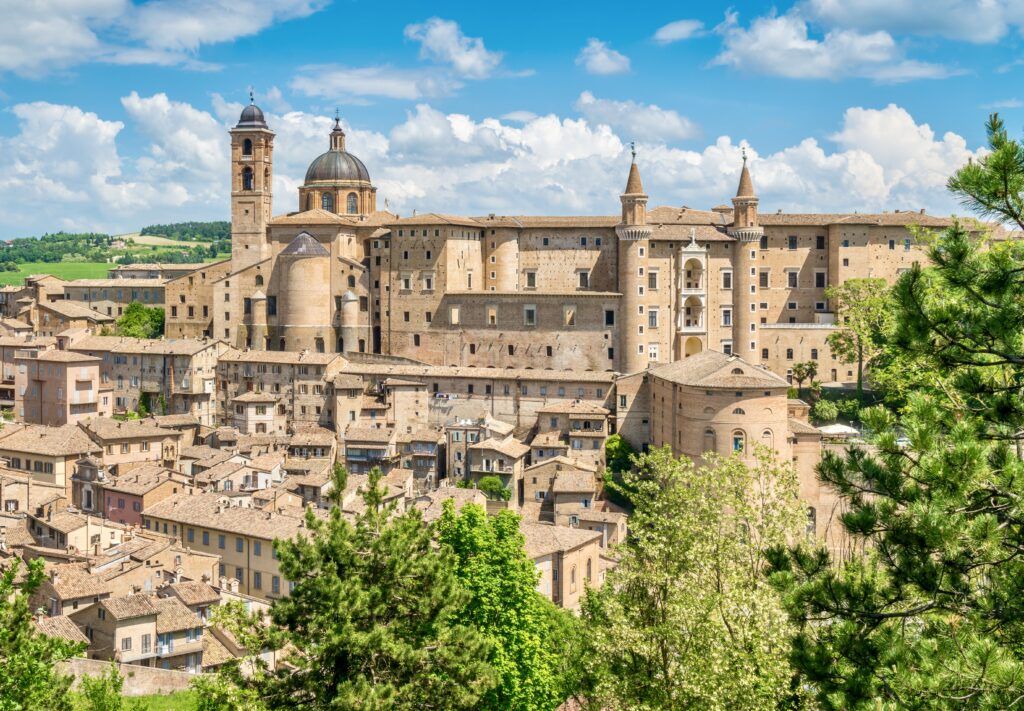
Tips For Spending One Day In Urbino
1. How To Get To Urbino
Urbino is remote and not terribly convenient to get to, which is why it’s one of Italy’s lesser visited cities. It’s located in the Le Marche region in the foothills of the Apennine Mountains, which run through the central part of the country.
Urbino is not particularly close to either Florence or Bologna, 140 and 120 miles away respectively.
The nearest towns are:
- Pesaro: 17 miles
- Ancona: 49 miles
- Rimini: 39 miles
- Gubbio: 42 miles (check out my guide to Gubbio)
The nearest major airport to Urbino is Federico Fellini International Airport (Rimini Airport), which is about 50 miles away. You can rent a car at the airport or take a train or bus to Urbino.
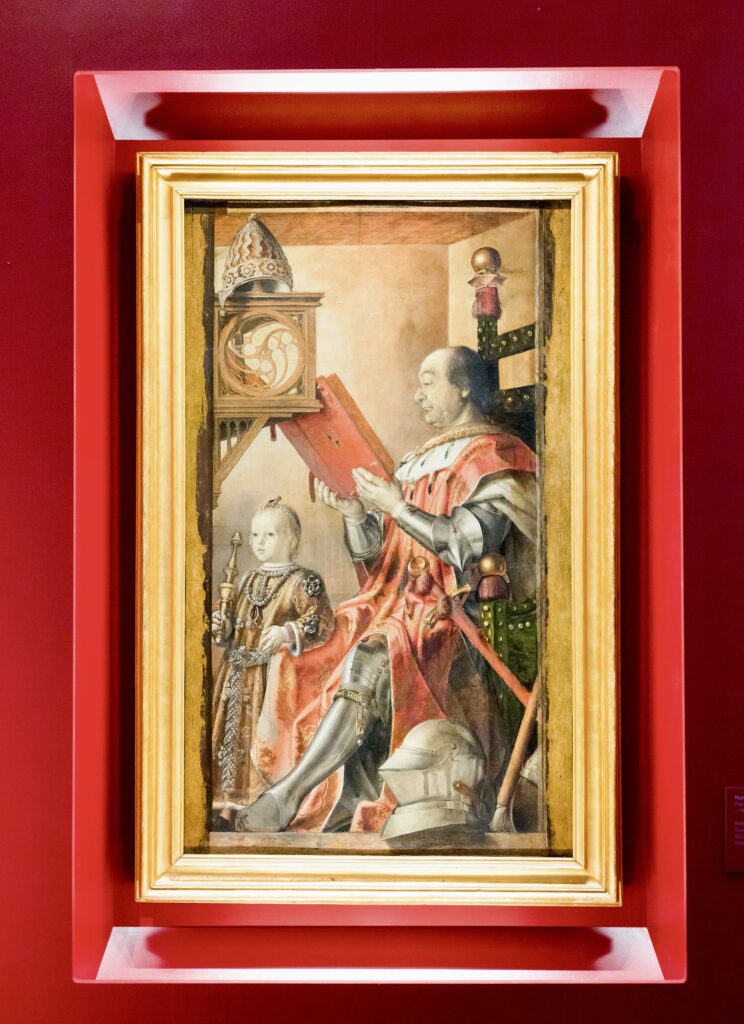
There is, inconveniently, no train station in Urbino either. The closest one is Pesaro Railway Station, about 18 miles from Urbino. From that station, you can take a bus or taxi to reach Urbino.
You can also get to Urbino by bus from Pesaro. Buses operate to and from Urbino’s Piazza Mercatale parking lot, situated below the town. They take at least 45 minutes.
From there, you have the option to either take an elevator that will transport you up to the base of the Ducal Palace or hike 5 minutes uphill via Via Mazzini to reach Piazza della Repubblica.
If you’re traveling by car (the easiest way to get to Urbino) you can reach Urbino via the A14 motorway (Autostrada A14). Take the Pesaro-Urbino exit and follow the signs to Urbino.
Be aware that the historic center of Urbino is a ZTL (Zona a Traffico Limitato). That means that only authorized vehicles are allowed within this area.
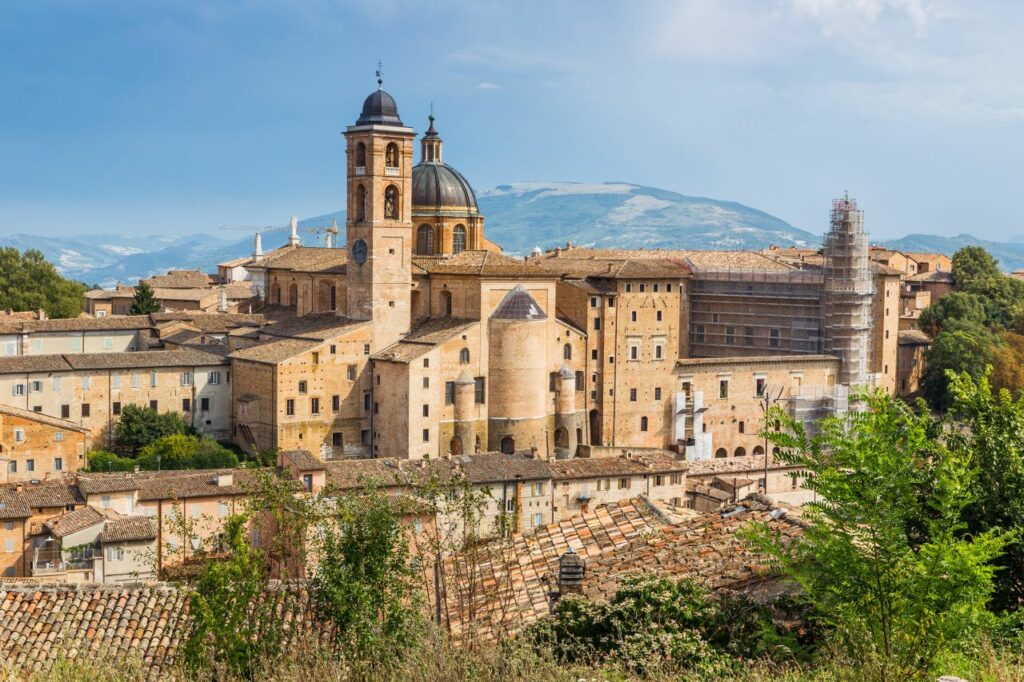
You can leave your car in Parcheggio del Mercatale (Mercatale Parking). It’s the most convenient lot, just outside the historic center.
2. How To Get Around Urbino
Urbino is a relatively small and pedestrian-friendly city. All the attractions are close together and the historic center is only .4 miles wide.
The best way to get around is on foot. But there are also local buses and taxis available.
3. When To Visit Urbino
The best time to visit Urbino is in the shoulder season, spring or fall. Summer sees the hottest weather and the largest crowds.
In winter, the weather is mild, but it can be damp. If so, walking on the steep cobbled streets can be treacherous.
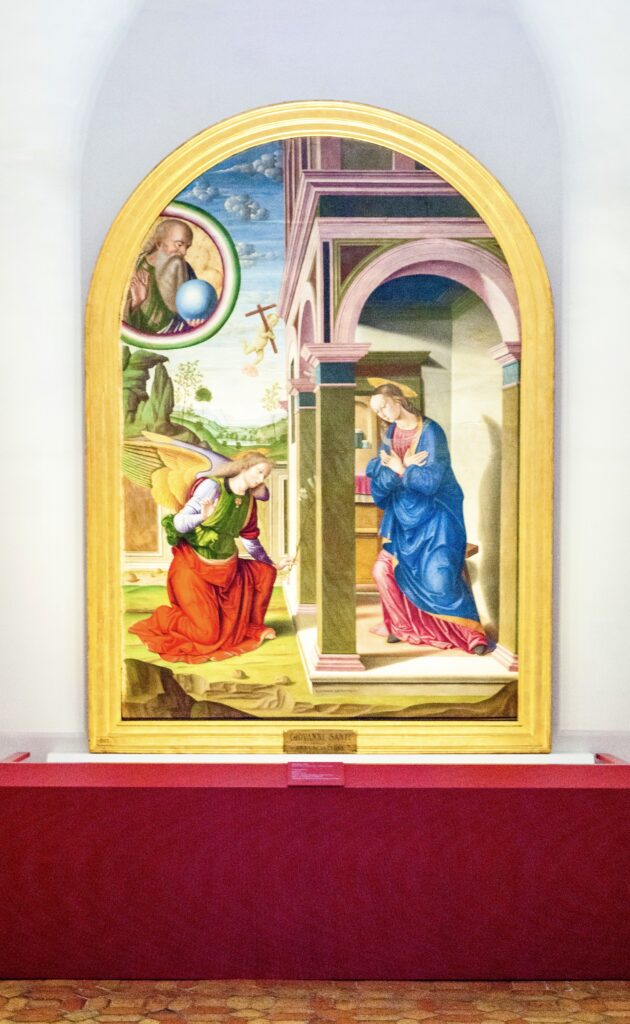
4. Where To Stay In Urbino
There are a few comfy places to stay in Urbino.
Hotel San Domenico is probably the best hotel in town. It’s a 4 star hotel in a former convent in the main square of Urbino.
The Aura Relais is a resort hotel located outside town in the hills of Le Marche. It has a pool, Turkish baths, and spa.
Albergo Italia was Urbino’s first hotel. It’s right in the center of the city just 5 minutes from the Ducal Palace.
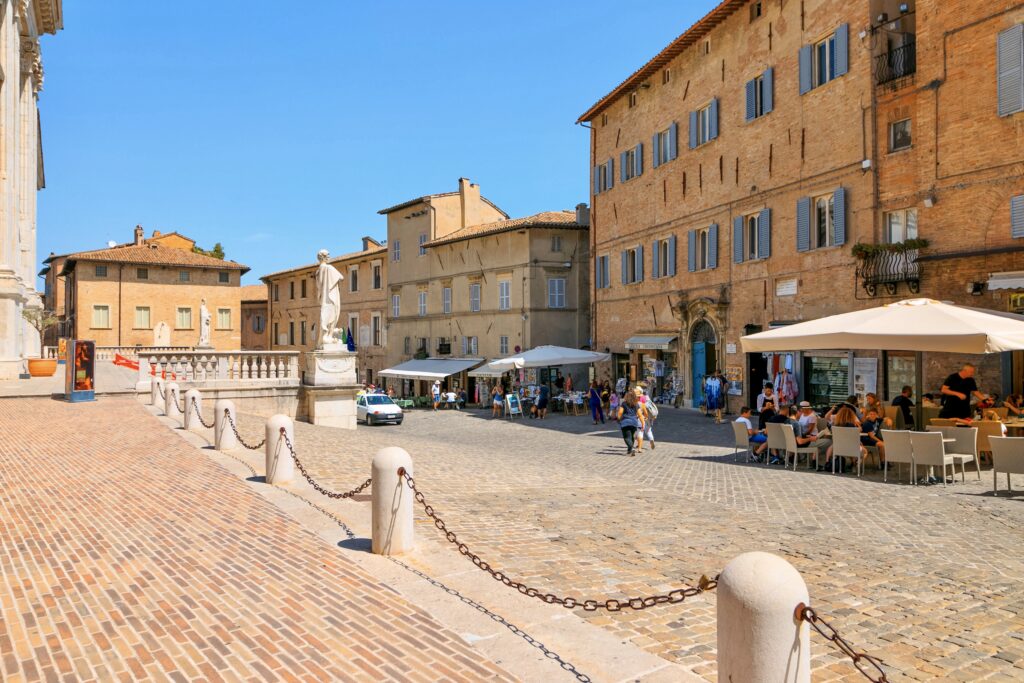
5. Is Urbino Worth Visiting?
If you are on the UNESCO trail in Europe or a fan of Renaissance art, Urbino is well worth a trek. You can literally step back 600 years in time to Renaissance Italy.
Nothing much has changed since the duke’s time. It’s worth visiting just to see the studiolo!
The region of Le Marche is also a great alternative to the much more crowded regions of Tuscany and Umbria. And Urbino itself is a hidden gem. You can see great art and architecture without any of the crowds of Florence.
I hope you’ve enjoyed my guide to the best things to do in Urbino in one day. You may enjoy these other Italy itineraries:
- 8 ways to spend 1 day in Rome
- 3 day itinerary for Rome
- 5 day itinerary for Rome
- 2 day itinerary for Florence
- 3 day itinerary for Florence
- 1 day in Venice itinerary
- 2 day itinerary for Venice
- 1 day itinerary for Milan
- 7 day itinerary for Umbria
- 10 day itinerary for Tuscany
- 10 day itinerary for Italy
- 12 ways to spend 1 week in Italy
If you’d like to spend a day in Urbino, pin it for later.

